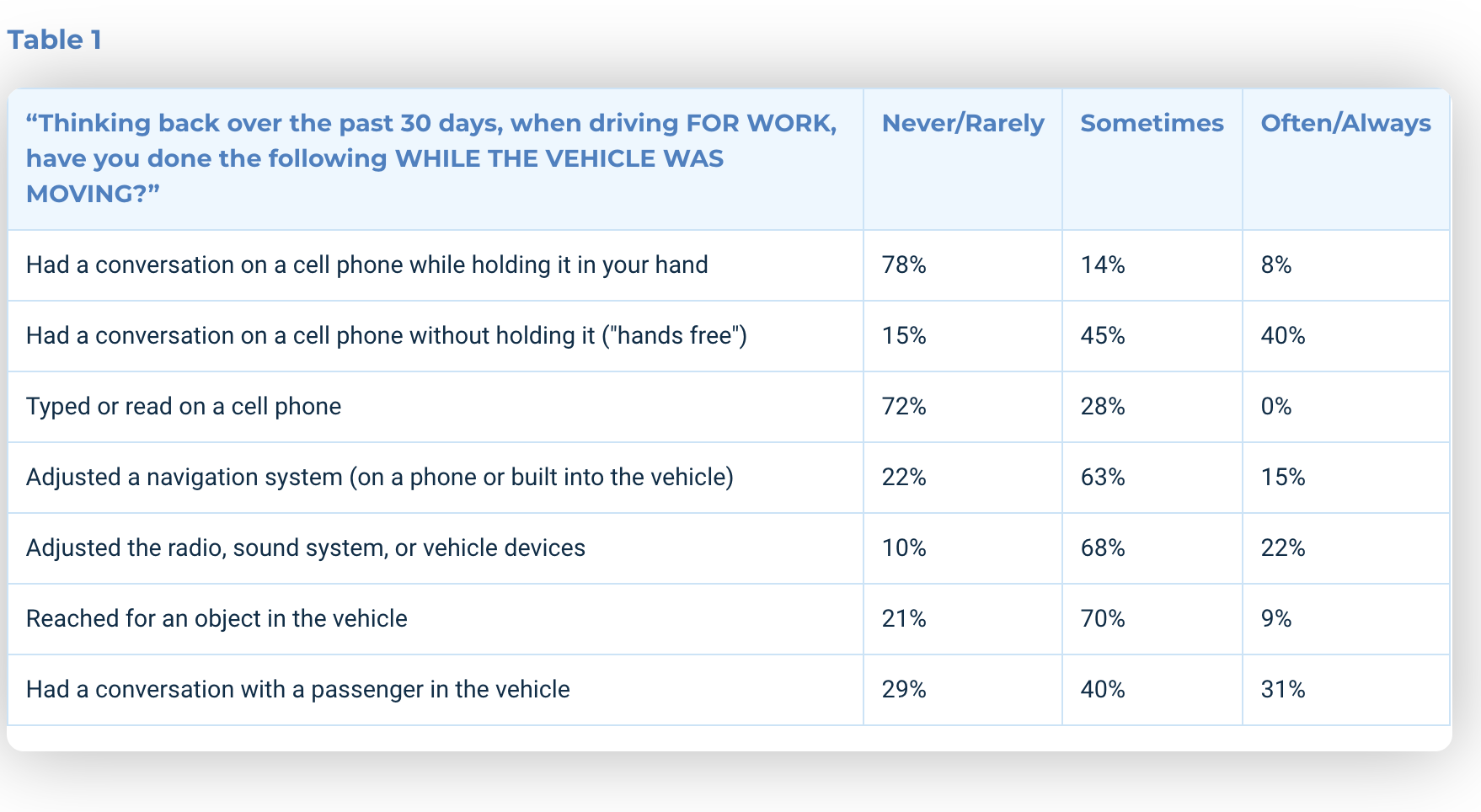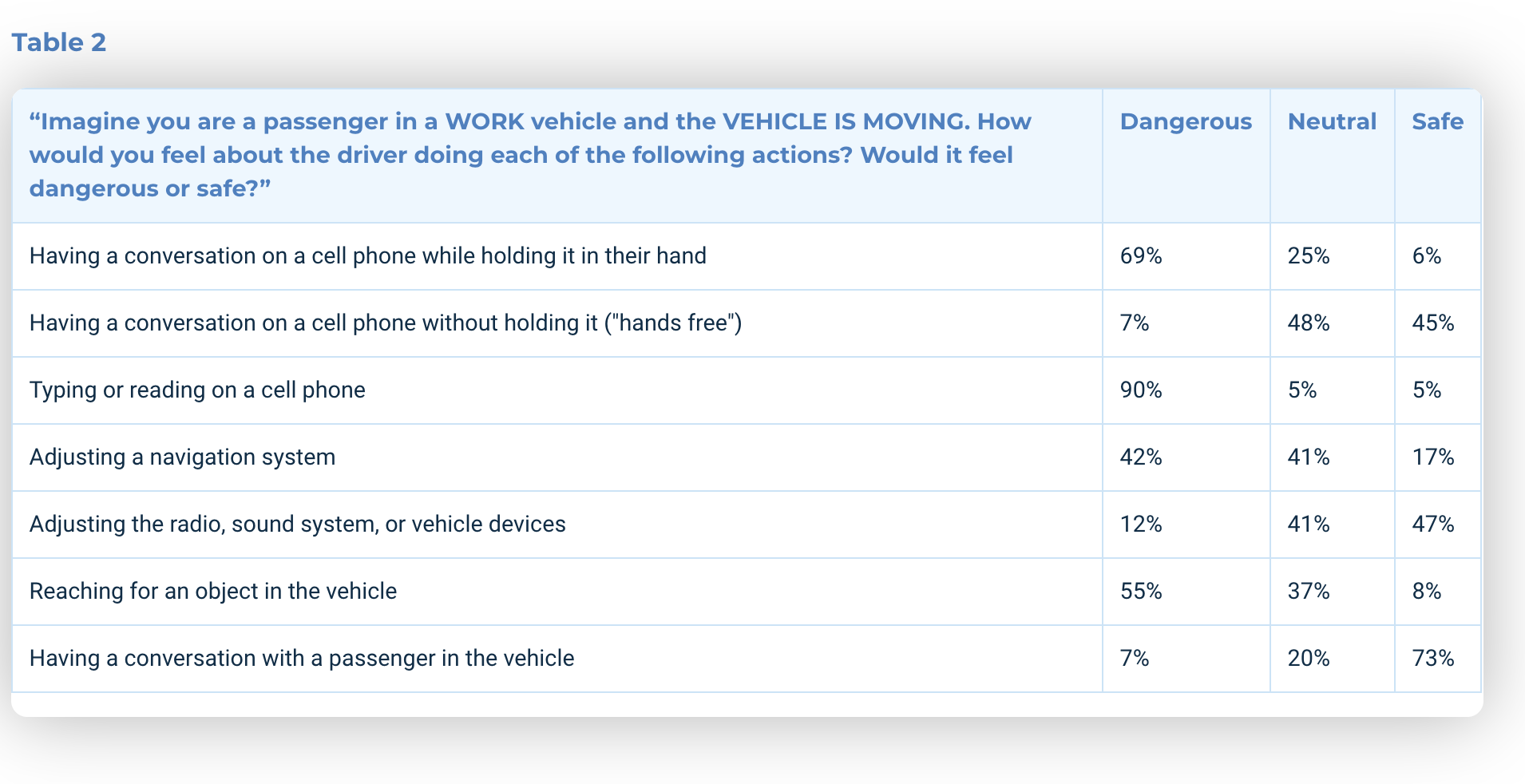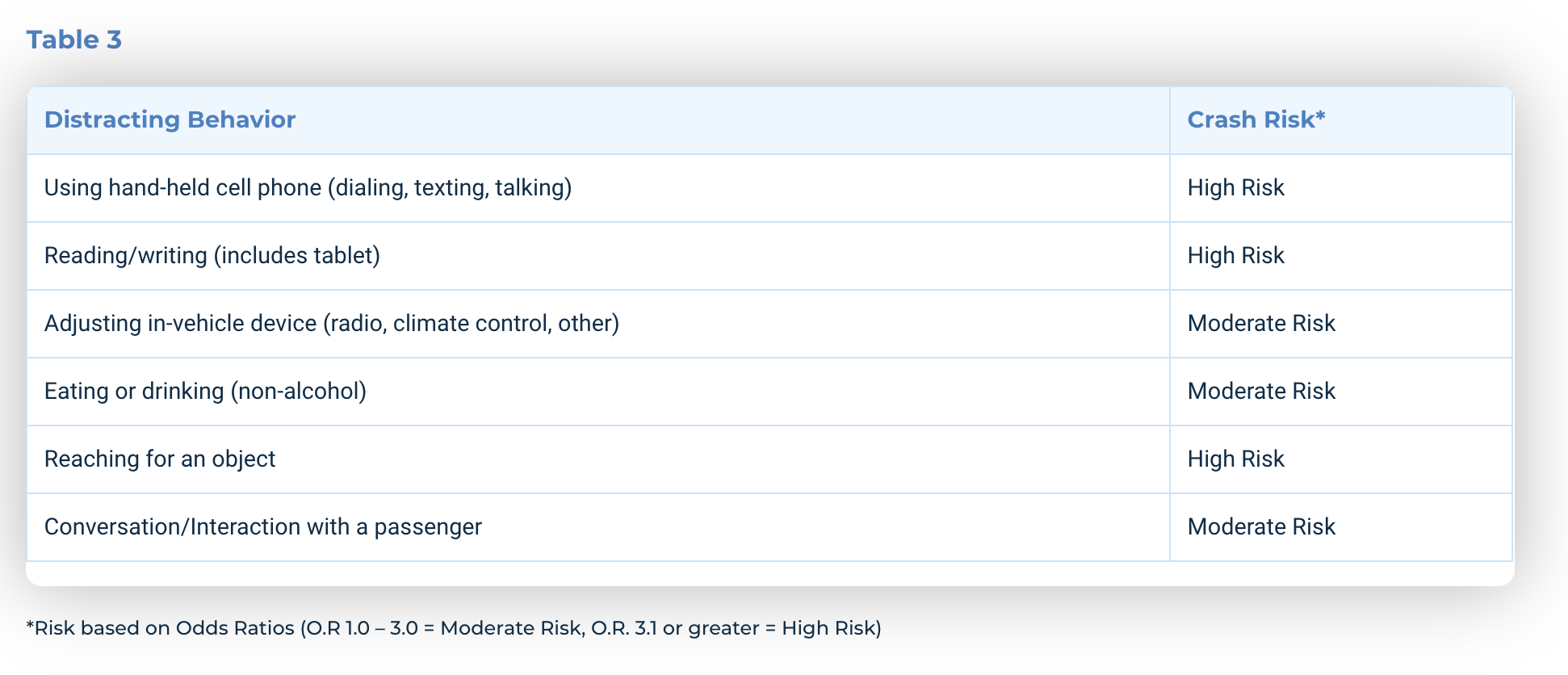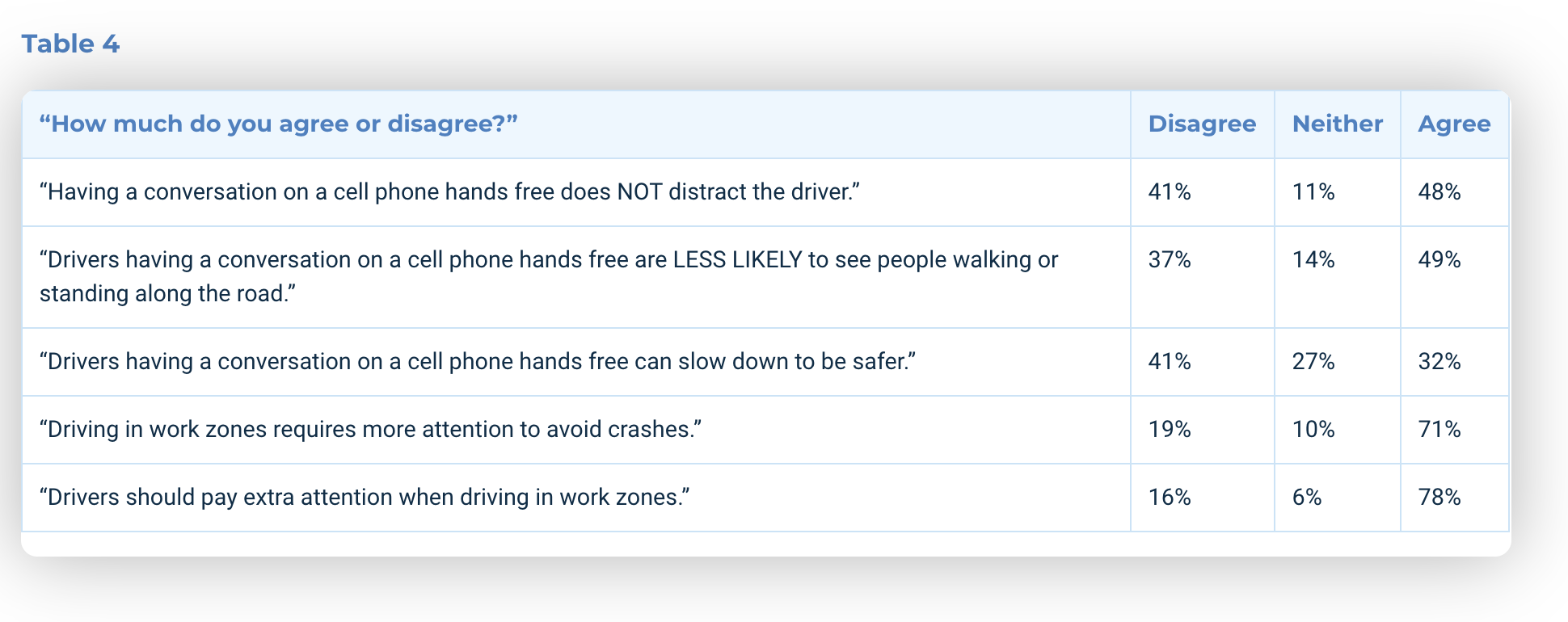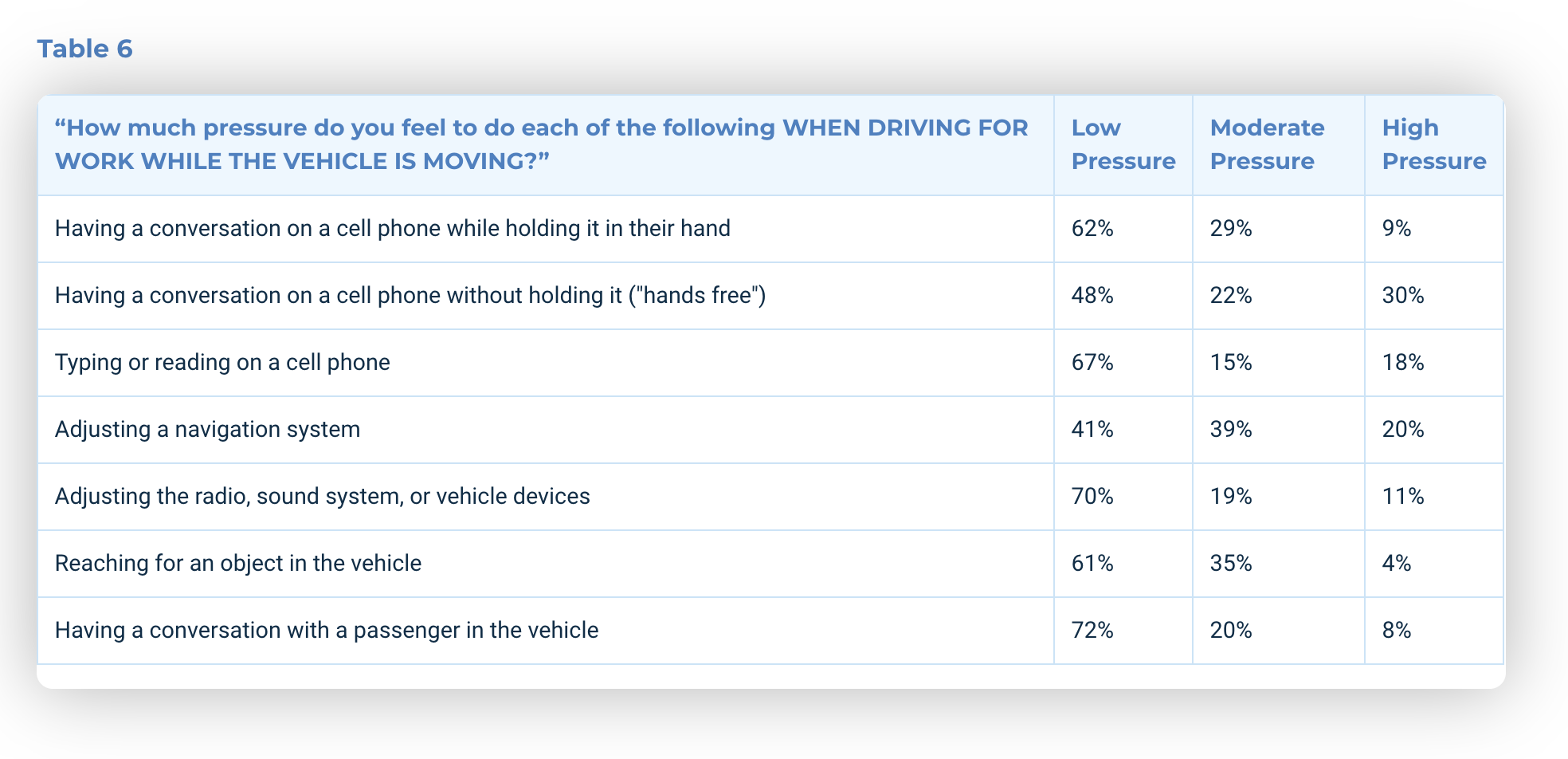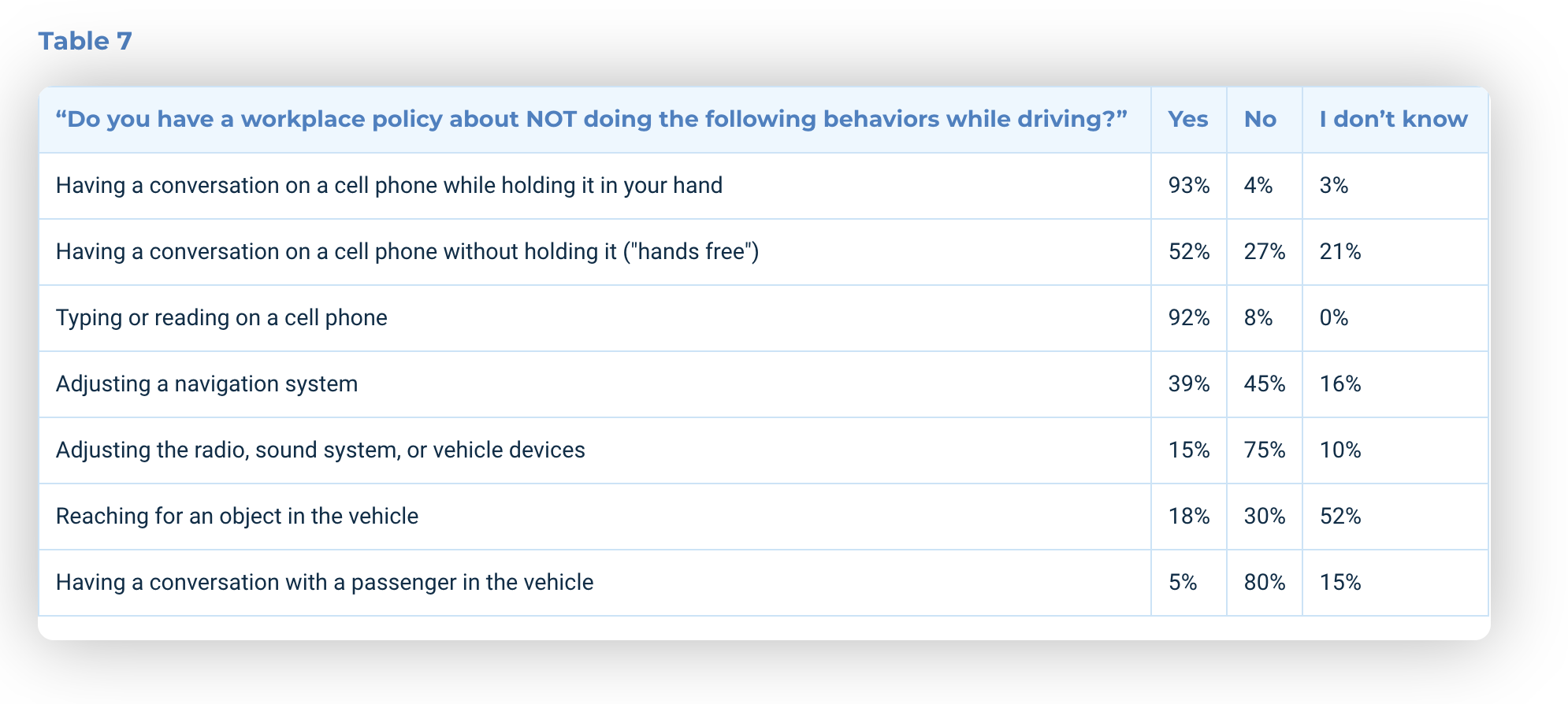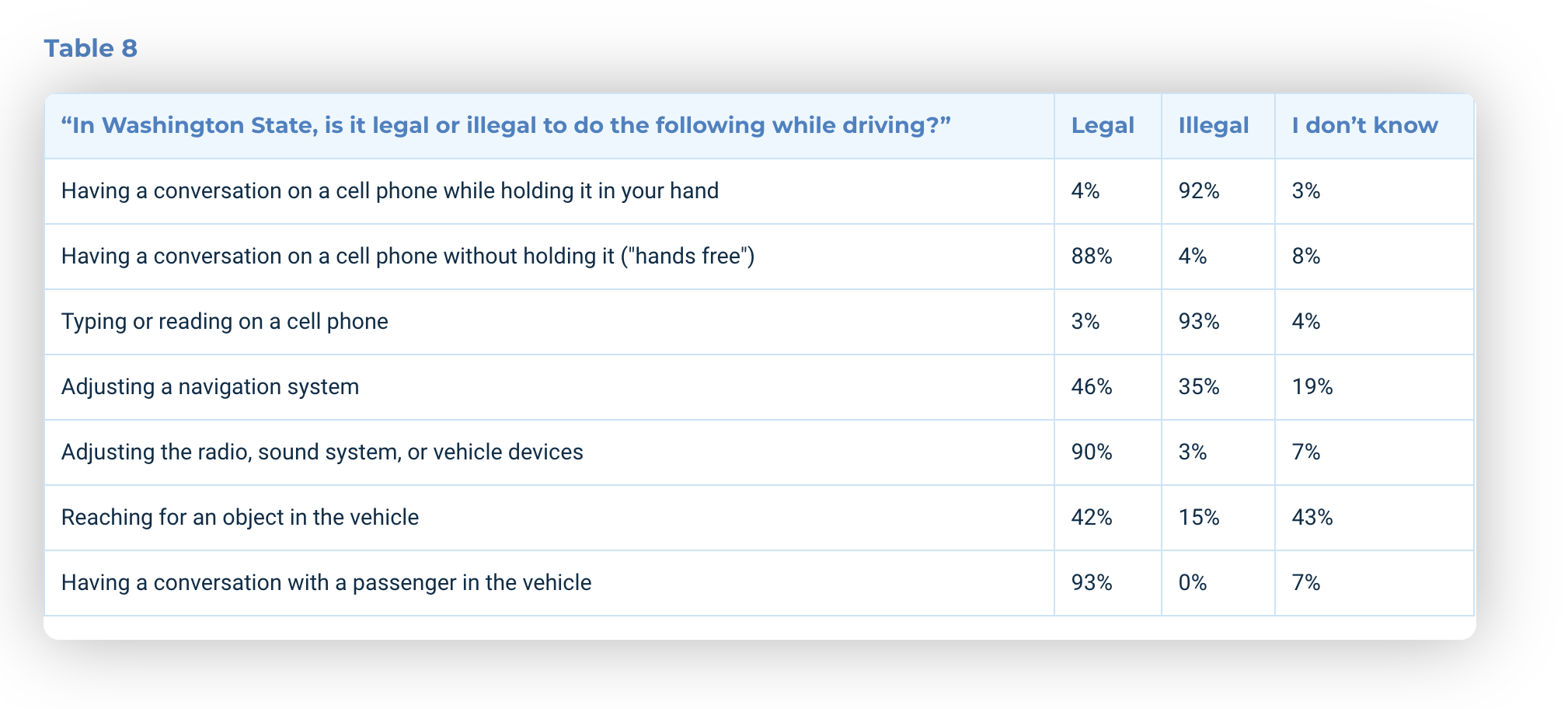STEP 1
Tool 1B
Sample Key Findings Report

Introduction
Traffic crashes are a leading cause of workplace injuries and fatalities, and distracted driving is a significant contributing factor to many traffic incidents.
In September 2019, ABC Workplace asked all its employees to complete an online survey to assess their beliefs and behaviors about distracted driving. The survey was provided in English and Spanish. Thirty-nine employees completed the survey. About half (48%) indicated they supervised or managed other employees.
The following report summarizes the responses of employees about their behaviors and beliefs about distracted driving. Understanding beliefs about behaviors reveals opportunities for change and ways to increase safety. There are many ways to change beliefs including training, supervision, and regular conversations. Recommendations are included at the end of the report.
Concern for Traffic Safety
Improving traffic safety begins by connecting with what people value. Most ABC Workplace employees (74%) who responded to the survey were concerned about safety on roads and highways. Furthermore, most (83%) agreed that the only acceptable number of deaths and serious injuries on our roadways should be zero (and 86% agreed the only acceptable number should be zero for deaths and injuries among coworkers).
These widely shared values provide a strong foundation for improving traffic safety culture at ABC Workplace. Leaders, managers, and supervisors should routinely reconnect with these shared values of concern about traffic safety and the importance of eliminating deaths and serious injuries on our roadways. Beginning conversations about traffic safety with values reinforces why this issue is important and requires everyone’s effort.
Prevalence of Distracted Driving Behaviors
Distracted driving is defined as driving while attempting to do any number of activities that takes the driver’s attention away from the task of driving. Table 1 summarizes the prevalence of engaging in various distracting behaviors while driving among employees at a Sample Company. Ideally, drivers should never engage in these behaviors while driving as they increase the chances of being in a crash.
| “Thinking back over the past 30 days, when driving FOR WORK, have you done the following WHILE THE VEHICLE WAS MOVING?” | Never/Rarely | Sometimes | Often/Always |
|---|---|---|---|
| Had a conversation on a cell phone while holding it in your hand | 78% | 14% | 8% |
| Had a conversation on a cell phone without holding it ("hands free") | 15% | 45% | 40% |
| Typed or read on a cell phone | 72% | 28% | 0% |
| Adjusted a navigation system (on a phone or built into the vehicle) | 22% | 63% | 15% |
| Adjusted the radio, sound system, or vehicle devices | 10% | 68% | 22% |
| Reached for an object in the vehicle | 21% | 70% | 9% |
| Had a conversation with a passenger in the vehicle | 29% | 40% | 31% |
Research has shown that engaging in conversations on a cell phone (hand-held or hands-free) or even with other passengers while driving increases the risk of a crash. Furthermore, adjusting navigation systems, the radio, or other vehicle devices as well as reaching for an object while the vehicle is moving are all dangerous.
It should be pointed out that many employees are making safe decisions. For example, most employees did not regularly (i.e., often or always) engage in distracting behaviors. Growing these safe decisions is critical to growing an overall strong safety culture. However, many employees have misperceptions about what other employees are doing. For example:
- 78% never or rarely had a conversation on a cell phone while holding it their hand.
However, two-thirds (65%) of employees thought that MOST employees regularly engage in “hand-held” cell phone conversations while driving.
- 72% never or rarely typed or read on a cell phone while driving.
However, two-thirds (68%) of employees thought that MOST employees do regularly type or read on cell phones while driving.
Correcting misperceptions about what most employees do will be an important component of growing safe behaviors. Leaders, managers, and supervisors can reinforce and grow safer decisions by regularly reminding employees about the safe choices that most employees are making.
Attitudes and Beliefs about Distracted Driving
Behaviors are influenced by beliefs. When people believe a behavior is dangerous, they are less likely to engage in it. Table 2 summarizes the beliefs of ABC Workplace employees about various distracting behaviors.
| “Imagine you are a passenger in a WORK vehicle and the VEHICLE IS MOVING. How would you feel about the driver doing each of the following actions? Would it feel dangerous or safe?” | Dangerous | Neutral | Safe |
|---|---|---|---|
| Having a conversation on a cell phone while holding it in their hand | 69% | 25% | 6% |
| Having a conversation on a cell phone without holding it ("hands free") | 7% | 48% | 45% |
| Typing or reading on a cell phone | 90% | 5% | 5% |
| Adjusting a navigation system | 42% | 41% | 17% |
| Adjusting the radio, sound system, or vehicle devices | 12% | 41% | 47% |
| Reaching for an object in the vehicle | 55% | 37% | 8% |
| Having a conversation with a passenger in the vehicle | 7% | 20% | 73% |
While many employees recognize that these behaviors are dangerous, many are neutral, and some think these behaviors are safe. Research has shown that these behaviors do increase crash risk.
Table 3 summarizes the crash risk of various distracting behaviors from published research. Studies have shown that various distracting behaviors increase the risk of being in a crash. Since ABC Workplace employees may be driving larger, heavier vehicles, the impact of a crash may be severe. Educating employees about the dangers of engaging in various distracting behaviors is an important component of growing safe behaviors.
| Distracting Behavior | Crash Risk* |
|---|---|
| Using hand-held cell phone (dialing, texting, talking) | High Risk |
| Reading/writing (includes tablet) | High Risk |
| Adjusting in-vehicle device (radio, climate control, other) | Moderate Risk |
| Eating or drinking (non-alcohol) | Moderate Risk |
| Reaching for an object | High Risk |
| Conversation/Interaction with a passenger | Moderate Risk |
*Risk based on Odds Ratios (O.R 1.0 – 3.0 = Moderate Risk, O.R. 3.1 or greater = High Risk)
Employees were asked how much they agreed with five statements about distracted driving. Their responses are summarized in Table 4.
| “How much do you agree or disagree?” | Disagree | Neither | Agree |
|---|---|---|---|
| “Having a conversation on a cell phone hands free does NOT distract the driver.” | 41% | 11% | 48% |
| “Drivers having a conversation on a cell phone hands free are LESS LIKELY to see people walking or standing along the road.” | 37% | 14% | 49% |
| “Drivers having a conversation on a cell phone hands free can slow down to be safer.” | 41% | 27% | 32% |
| “Driving in work zones requires more attention to avoid crashes.” | 19% | 10% | 71% |
| “Drivers should pay extra attention when driving in work zones.” | 16% | 6% | 78% |
Research has clearly established that conversations on cell phones do distract the driver – regardless of whether the drive is holding the phone or not. For example, studies have shown that drivers are less likely to see people walking or standing along the road when engaged in a conversation. Educating employees about how conversations are distracting is an important component of growing safe behaviors.
Some people believe that they can simply slow down while engaged in a distracting behavior (like talking on a cell phone) and they will be safer. This is called a “compensating belief” – a belief that allows people to justify engaging in a potentially dangerous behavior. The best way to reduce risk associated with distracting behaviors is to avoid the distracting behaviors and stay focused on the driving task.
Work zones can be particularly dangerous as normal traffic patterns are interrupted and workers and equipment are often present. Distracting driving is particularly dangerous in work zones.
Perceptions of Expectations of Supervisors
Managers and supervisors can significantly influence employee behaviors. Table 5 summarizes how employees perceive the expectations of supervisors about whether various distracting behaviors are “OK” or “not OK.”
| “How do you think your immediate supervisor feels about you doing each of the following WHEN DRIVING FOR WORK WHILE THE VEHICLE IS MOVING?” | Not OK | Neutral | OK |
|---|---|---|---|
| Having a conversation on a cell phone while holding it in your hand | 92% | 8% | 0% |
| Having a conversation on a cell phone without holding it ("hands free") | 30% | 29% | 41% |
| Typing or reading on a cell phone | 95% | 5% | 0% |
| Adjusting a navigation system | 58% | 27% | 15% |
| Adjusting the radio, sound system, or vehicle devices | 21% | 48% | 31% |
| Reaching for an object in the vehicle | 76% | 24% | 0% |
| Having a conversation with a passenger in the vehicle | 12% | 30% | 58% |
These perceptions are a significant predictor of employee behavior. While many perceived their supervisor thought it was not OK to engage in some distracting behaviors (like typing or reading on a cell phone), employees had varying perceptions about hands free cell phone conversations and other potentially distracting behaviors.
Having managers and supervisors clearly establish expectations with those they oversee is an important component of growing safe behaviors.
Sense of Pressure to Engage in Distracting Behaviors
The degree to which people feel they are in control can influence their behaviors. Sometimes people know certain behaviors are potentially dangerous but still engage in them because they feel like they have to, that is, they feel they have no choice or they feel pressure to do so. Table 6 summarizes how much pressure employees feel about engaging in various distracting behaviors.
| “How much pressure do you feel to do each of the following WHEN DRIVING FOR WORK WHILE THE VEHICLE IS MOVING?” | Low Pressure | Moderate Pressure | High Pressure |
|---|---|---|---|
| Having a conversation on a cell phone while holding it in their hand | 62% | 29% | 9% |
| Having a conversation on a cell phone without holding it ("hands free") | 48% | 22% | 30% |
| Typing or reading on a cell phone | 67% | 15% | 18% |
| Adjusting a navigation system | 41% | 39% | 20% |
| Adjusting the radio, sound system, or vehicle devices | 70% | 19% | 11% |
| Reaching for an object in the vehicle | 61% | 35% | 4% |
| Having a conversation with a passenger in the vehicle | 72% | 20% | 8% |
Employees reported varying levels of pressure to engage in distracting behaviors. Over 35% reported moderate or high pressure to engage in cell phone conversations while holding the cell phone or to type or read on a cell phone while driving. Even more reported moderate or high pressure to engage in hands free cell phone conversations. Over 40% reported moderate or high pressure to reach for objects while driving.
Managers and supervisors can work with employees to better understand the sources of these feelings of pressure. Work routines or communication strategies can be adjusted so that employees do not feel pressure to engage in dangerous behaviors.
Knowledge of Workplace Policies and State Laws
Table 7 summarizes the knowledge of employees about workplace policies on distracted driving. Most employees indicated there is a policy about not having conversations on hand-held cell phones and about not typing or reading on a cell phone. Employees seemed to be unclear about policies on other distracting behaviors.
| “Do you have a workplace policy about NOT doing the following behaviors while driving?” | Yes | No | I don’t know |
|---|---|---|---|
| Having a conversation on a cell phone while holding it in your hand | 93% | 4% | 3% |
| Having a conversation on a cell phone without holding it ("hands free") | 52% | 27% | 21% |
| Typing or reading on a cell phone | 92% | 8% | 0% |
| Adjusting a navigation system | 39% | 45% | 16% |
| Adjusting the radio, sound system, or vehicle devices | 15% | 75% | 10% |
| Reaching for an object in the vehicle | 18% | 30% | 52% |
| Having a conversation with a passenger in the vehicle | 5% | 80% | 15% |
Table 8 summarizes the perceptions of employees about distracted driving laws in Washington State. Most indicated that there is a law prohibiting hand-held cell phone conversations and prohibiting typing or reading on a cell phone.
In fact, Washington State has a law that any behavior that distracts a driver and results in dangerous driving or a crash is considered a distracted driving violation. Therefore, all the behaviors listed can result in a distracted driving violation.
| “In Washington State, is it legal or illegal to do the following while driving?” | Legal | Illegal | I don’t know |
|---|---|---|---|
| Having a conversation on a cell phone while holding it in your hand | 4% | 92% | 3% |
| Having a conversation on a cell phone without holding it ("hands free") | 88% | 4% | 8% |
| Typing or reading on a cell phone | 3% | 93% | 4% |
| Adjusting a navigation system | 46% | 35% | 19% |
| Adjusting the radio, sound system, or vehicle devices | 90% | 3% | 7% |
| Reaching for an object in the vehicle | 42% | 15% | 43% |
| Having a conversation with a passenger in the vehicle | 93% | 0% | 7% |
Speaking Up to Prevent Distracted Driving
Simply complying with a policy is the minimum expectation from employees. The ultimate goal is for employees to embrace their role in creating a culture of safety. This means employees actively make the workplace safer by discussing what is appropriate and reminding one another about safe practices. This creates a general expectation that people look out for each other and speak up to prevent unsafe behaviors.
Almost two-thirds (64%) of employees who responded to the survey indicated they had been in a situation at least once in the past thirty days when a coworker was doing something that was potentially distracting them from driving. This indicates there are many opportunities for employees to speak up and improve safety.
Among employees who were in these situations, about one-quarter (23%) reported they asked the coworker to stop the distracting behavior half the time or more often. Therefore, while many employees find themselves in situations where they could speak up, there is room to improve by speaking up more often.
Importantly, most employees (63%) reported they were very comfortable in asking a coworker to stop doing something that was potentially distracting them from driving. This reveals that the overall culture supports speaking up. Talking to employees about how to speak up will grow their comfort and confidence and increase actions.
When employees embrace their role in creating a culture of safety by avoiding unsafe behaviors and asking others to avoid unsafe behaviors, overall safety improves.
Next Steps
The following are recommendations to improve traffic safety culture at ABC Workplace by specifically addressing distracted driving.
1.
Review current distracted driving policies and consider addressing a variety of distracting behaviors such as cell phone use, interacting with navigation systems or vehicle equipment, reaching for objects, general conversations, and any behaviors that potentially distract a driver from the driving task.
2.
Review and potentially revise safety training to clarify
- the danger of various distracting behaviors;
- that engaging in conversations (including on hands-free cell phones) is distracting even if the driver is looking ahead. Conversations distract the driver’s attention and mental engagement in the driving task.
- that slowing down is not an acceptable way to reduce the danger of engaging in a distracting behavior. The only safe solution is to stop the distracting behavior or pull off the road in a safe place.
- that driving in work zones presents additional hazards and requires more attention; and
- expectations about what to do if a coworker is engaging in a distracting behavior.
3.
Work with those in a supervisory role (at all levels of the organization) to
- bolster efforts at establishing clear expectations about avoiding distracting behaviors while driving with those that report to them. Guidance about these conversations is provided in the toolkit.
- explore whether employees feel a sense of pressure to engage in distracting behaviors. The sources of pressure should be discussed and ways to reduce these sources of pressure should be identified.
- make sure employees understand and follow ABC Workplace’s policies and Washington State laws.
- increase employees’ sense of comfort in speaking up if they see a driver engaging in distracting behaviors. This may require practice (guidance is included in the toolkit).
- continually revisit these topics in ongoing conversations with employees. Beliefs and behaviors do not change immediately and require sustained effort.
Questions to consider
- Do you collect crash data?
- Do you know the prevalence of distracted driving among your employees?
- Do you know the consequences of distracted driving for your workplace?


